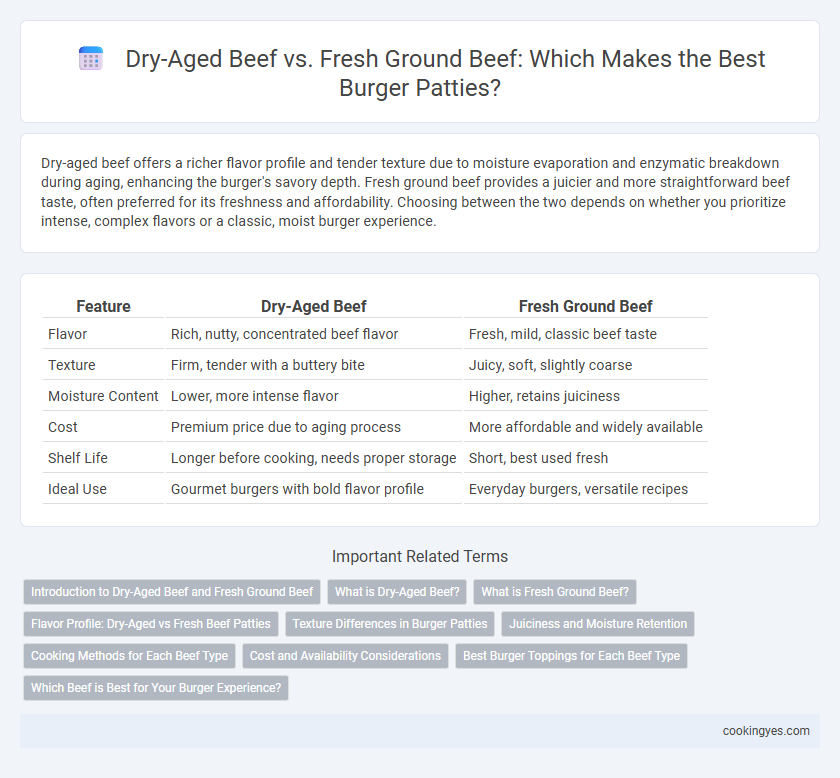Dry-aged beef offers a richer flavor profile and tender texture due to moisture evaporation and enzymatic breakdown during aging, enhancing the burger's savory depth. Fresh ground beef provides a juicier and more straightforward beef taste, often preferred for its freshness and affordability. Choosing between the two depends on whether you prioritize intense, complex flavors or a classic, moist burger experience.
Table of Comparison
| Feature | Dry-Aged Beef | Fresh Ground Beef |
|---|---|---|
| Flavor | Rich, nutty, concentrated beef flavor | Fresh, mild, classic beef taste |
| Texture | Firm, tender with a buttery bite | Juicy, soft, slightly coarse |
| Moisture Content | Lower, more intense flavor | Higher, retains juiciness |
| Cost | Premium price due to aging process | More affordable and widely available |
| Shelf Life | Longer before cooking, needs proper storage | Short, best used fresh |
| Ideal Use | Gourmet burgers with bold flavor profile | Everyday burgers, versatile recipes |
Introduction to Dry-Aged Beef and Fresh Ground Beef
Dry-aged beef undergoes a controlled aging process that enhances tenderness and intensifies flavor by allowing natural enzymes to break down muscle fibers over several weeks. Fresh ground beef, often sourced directly from recently butchered cuts, offers a juicier texture and a milder, more straightforward beef flavor ideal for traditional burger patties. Choosing between dry-aged and fresh ground beef influences the burger's taste profile, texture, and overall gourmet experience.
What is Dry-Aged Beef?
Dry-aged beef is a premium type of beef that undergoes a controlled aging process in a refrigerated environment, where natural enzymes break down muscle tissue to enhance tenderness and intensify flavor. This method typically lasts from 14 to 60 days, resulting in a more complex, nutty, and beefy taste compared to fresh ground beef. Unlike fresh ground beef, which offers a milder flavor and softer texture, dry-aged beef produces burger patties with a rich, concentrated meat profile prized by gourmet chefs and burger aficionados.
What is Fresh Ground Beef?
Fresh ground beef is made by grinding raw beef shortly before cooking, preserving its natural moisture and bright red color while retaining essential nutrients and flavor. It typically comes from freshly trimmed cuts such as chuck, sirloin, or round, offering a balanced fat-to-lean ratio ideal for juicy burger patties. Compared to dry-aged beef, fresh ground beef is more affordable and readily available, catering to everyday burger recipes with a classic, straightforward beef taste.
Flavor Profile: Dry-Aged vs Fresh Beef Patties
Dry-aged beef burger patties exhibit a rich, concentrated flavor with nutty and umami undertones due to moisture evaporation and enzymatic breakdown during aging. Fresh ground beef patties deliver a more straightforward, mildly metallic taste with pronounced beefy freshness and juiciness. The choice between dry-aged and fresh beef profoundly impacts the burger's depth, complexity, and overall flavor experience.
Texture Differences in Burger Patties
Dry-aged beef burger patties develop a firmer, more complex texture due to moisture evaporation and enzymatic breakdown during aging, resulting in a tender yet slightly chewy bite. Fresh ground beef patties maintain a higher moisture content, leading to a juicier and softer texture but lacking the nuanced mouthfeel of dry-aged meat. The contrast in texture significantly influences the overall burger experience, with dry-aged patties offering a richer, more pronounced beef flavor combined with a unique textured bite.
Juiciness and Moisture Retention
Dry-aged beef offers a more intense flavor profile but tends to have lower juiciness and moisture retention compared to fresh ground beef. Fresh ground beef retains higher water content, resulting in juicier burger patties that maintain moisture during cooking. For optimal juiciness and moisture retention, fresh ground beef remains the preferred choice for burger patties.
Cooking Methods for Each Beef Type
Dry-aged beef requires careful cooking over medium heat to preserve its enhanced flavor and tender texture, typically suited for thicker burger patties cooked to medium-rare or medium doneness. Fresh ground beef benefits from higher heat methods like grilling or pan-searing to quickly seal juices and achieve a well-browned crust, ideal for thinner patties cooked thoroughly to at least medium. Each cooking approach maximizes the specific qualities of dry-aged and fresh ground beef, impacting taste, juiciness, and texture in the final burger.
Cost and Availability Considerations
Dry-aged beef for burger patties often costs significantly more due to the time-intensive aging process and specialized storage requirements, making it less accessible for everyday use. Fresh ground beef is widely available, more affordable, and offers a convenient option for both home cooks and restaurants. While dry-aged beef delivers premium flavor, its higher price and limited availability can impact budgeting and supply consistency in burger preparation.
Best Burger Toppings for Each Beef Type
Dry-aged beef pairs exceptionally well with bold toppings such as sharp blue cheese, caramelized onions, and smoked bacon, enhancing its rich and concentrated flavor profile. Fresh ground beef complements classic toppings like cheddar cheese, crisp lettuce, ripe tomatoes, and pickles that highlight its juicy and tender texture. Choosing the right toppings based on beef type optimizes the overall taste experience of gourmet and traditional burgers alike.
Which Beef is Best for Your Burger Experience?
Dry-aged beef offers intense flavor and improved tenderness due to moisture evaporation and enzymatic breakdown during the aging process, creating a richer burger experience. Fresh ground beef provides a juicier, more straightforward taste with higher moisture content, ideal for classic, juicy burgers. Choosing between dry-aged and fresh ground beef depends on whether you prioritize robust, complex flavors or traditional juiciness in your burger patties.
Dry-aged beef vs Fresh ground beef for burger patties Infographic

 cookingyes.com
cookingyes.com